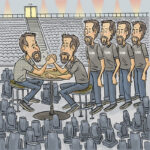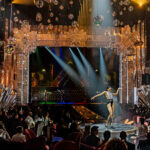Many consoles utilize a DMX based library system instead of a generic library. This means that data is always programmed and stored as DMX values for fixture parameters. This manner of data storage makes changing fixture types much more complicated and error-prone. Typically these consoles allow the programmer to clone data from one fixture type to another, but remember that only the DMX values are being copied, so this can lead to extreme changes. For instance, one fixture's strobe value may copy into another fixture with very different strobe rates. When working with these types of consoles, it is important to copy the palette (preset) data first, then the cue data. If you copy the cue data first, then you will likely lose palette references within your cues. Furthermore, remember that it can be very time consuming to copy individual cues throughout a show. Try to make use of macros to speed up the process. Some consoles with a basic DMX library may have an automated method to clone data, but the result still needs to be studied, as differences in fixture DMX values are not usually corrected.
From "Feeding the Machines" by Brad Schiller, PLSN, May 2010


